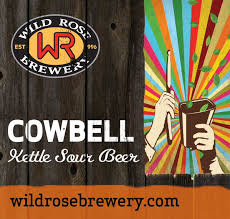 Kettle souring is a thing. It has gone from nowhere to relatively common in the U.S. in relatively short order. And now it has come home to Alberta. Wild Rose just released Cow Bell, their first kettle soured beer, and I am told the folks at Blindman Brewing will soon be working on one as well (and have, in fact, designed their brewhouse to efficiently handle kettle souring).
Kettle souring is a thing. It has gone from nowhere to relatively common in the U.S. in relatively short order. And now it has come home to Alberta. Wild Rose just released Cow Bell, their first kettle soured beer, and I am told the folks at Blindman Brewing will soon be working on one as well (and have, in fact, designed their brewhouse to efficiently handle kettle souring).
All of this interest piqued my interest in the topic. Not only is it an interesting story to tell beer fans, I also have visions of trying the process at home. I have always been a sour chicken because I have been paranoid of contaminating my home brewery. Kettle souring may give me a safer option.
I made kettle souring the topic of my CBC column last Friday. It has been a couple years since CBC actually posted my columns online – due to lack of resources – but they have renewed a commitment to post my columns on their website, starting last Friday (could there be a connection to the recent Federal election and the defeat of the CBC-hating Harper Conservatives??? Nah!!).
You can listen to the column here.
For the uninitiated, kettle souring is a fast method for creating sour beer. For centuries certain styles featured a sharp, tangy tartness. Lambic, Flanders Red and Berliner Weisse are just a few classic examples. They developed the sourness from various strains of Lactobacillus (the bacteria key to creating yogurt) that work alongside (or after) the Saccromyces yeast during the fermentation and/or aging stages.
The issue is that souring takes time – up to three years in lambics – and poses a serious risk of running rampant in your brewhouse. So unless you were an exclusive sour beer producer, it could be tricky.
Kettle souring reverses the process. Lactobacillus is added to the wort before boiling. The wort is then left to sit in the brew kettle for 24 hours or so (until desired degree of sourness is achieved). The wort is then boiled – killing off the Lactobacillus and stabilizing the beer. It is then fermented, conditioned and packaged as normal.
Reports have it that the fermentation is a bit more sluggish due to the low pH levels but tends to work out just fine. Those same reporters also argue that the sourness is very clean but a bit more one-dimensional than traditionally soured beer. My (very) limited experience matches that report.
Still, it can create an interesting beer that, I argue, can be a nice gateway into the world of sour beer. Wild Rose’s Cow Bell is light, fruity and cleanly tart with a definite citrus accent to it. Looking forward to trying Blindman’s version(s).
For the record – and I find this VERY cool – Wild Rose told me for the Lactobacillus they simply dumped in a dose of low-fat, probiotic yogurt (I neglected to ask how much). Yogurt! How is that for a low tech beer-hack? I could totally do that at home, with the only cost being the slightly vexed looked from my family for stealing some of the yogurt in the fridge. Wild Rose also told me they adjusted the pH of the wort with lactic acid before pitching the yogurt and then let the wort sit for around 24 hours at 42 Celsius.
Traditionalists may wrinkle their noses at kettle souring, but I for one think it is an interesting, intriguing way to expand the flavour range of beer. Sure, they ain’t no Lambic, but they aren’t trying to be. My response to the traditionalist would be “try to appreciate it for what it is”. Which is pretty cool.


January 27, 2016 at 9:10 AM
If you are interested in more info on lacto sources (ie yogurt) check out the milk the funk wiki http://www.milkthefunk.com/wiki/Alternative_Bacteria_Sources#Yogurt_Souring
Dandy uses a kettle souring method with their sours as well and they have used grain and probiotics to get lacto into their kettle.
January 27, 2016 at 7:50 PM
We use yogurt in ours as well. A couple containers is plenty for a 2,000L batch
January 28, 2016 at 8:06 PM
The fact that Wild Rose “adjusted the pH of the wort with lactic acid” makes me wonder how much of the acidity was a result of the yogurt as opposed to the added lactic acid.
January 28, 2016 at 8:16 PM
Dropping the pH to 4.5 is common practice for kettle sours as it inhibits the growth of non LAB bugs. Lacto also consumes protein above 4.5 which destroys body and head retention.
January 29, 2016 at 6:29 AM
Thanks.
January 29, 2016 at 12:10 PM
Yep, we do this as well. We didnt on the first batch, and it had a touch of sulfur.
February 5, 2016 at 10:25 PM
We’ve packaged 5 (a 6th tomorrow) sours so far and as Chris mentioned, have used a few different sources for bacteria, so far we haven’t had any issues hitting our target pH. Each one has been a great experience and provided some interesting character! Definitely a fun one to work with. Come check em’out!